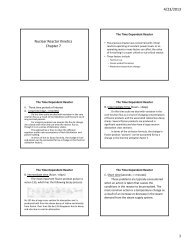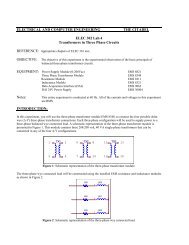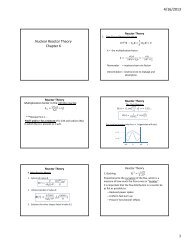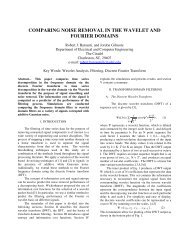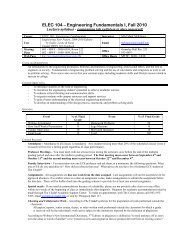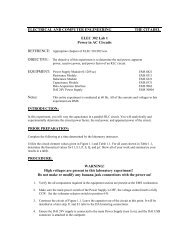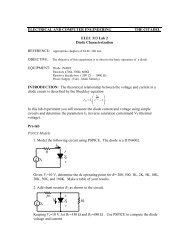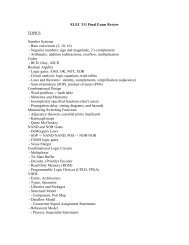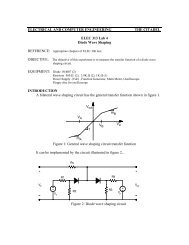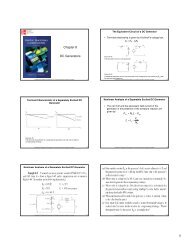Q1. A 120V, dc motor has shunt field windings of 500 turns and field ...
Q1. A 120V, dc motor has shunt field windings of 500 turns and field ...
Q1. A 120V, dc motor has shunt field windings of 500 turns and field ...
You also want an ePaper? Increase the reach of your titles
YUMPU automatically turns print PDFs into web optimized ePapers that Google loves.
<strong>Q1.</strong> A <strong>120V</strong>, <strong>dc</strong> <strong>motor</strong> <strong>has</strong> <strong>shunt</strong> <strong>field</strong> <strong>windings</strong> <strong>of</strong> <strong>500</strong> <strong>turns</strong> <strong>and</strong> <strong>field</strong> resistance <strong>of</strong> R F = 100 Ω <strong>and</strong><br />
armature resistance <strong>of</strong> R A = 0.10 Ω. The full load current is 40 A, <strong>and</strong> it produces an armature<br />
reaction <strong>of</strong> 100 A-Turns.<br />
140<br />
120<br />
Magnetization Curve at 2400 rpm<br />
2400 rpm<br />
Armature Voltage (V)<br />
100<br />
80<br />
60<br />
40<br />
20<br />
0<br />
0 0.5 1 1.5 2<br />
Field Current (A)<br />
a) Equivalent circuit goes in this box.<br />
(a)(1) Sketch the DC <strong>motor</strong> equivalent circuit in the box above.<br />
Show all components <strong>and</strong> label currents <strong>and</strong> voltages.<br />
(b)(3) What is the full load speed (N FL ) <strong>of</strong> this <strong>motor</strong> in rpm?<br />
(c)(3) What is the full load torque (T) available at the shaft?<br />
(d)(3) What is the <strong>motor</strong> efficiency?<br />
b) N FL = ___________<br />
c) T = ___________<br />
d) % η = ___________
Q2. A permanent magnet DC generator <strong>has</strong> an armature resistance <strong>of</strong> 4.0 ohms <strong>and</strong> operates at<br />
1200 rpm with constant rotational losses <strong>of</strong> 100 W. At no load, a voltage <strong>of</strong> 140V is produced.<br />
(a)(1) Sketch the generator armature circuit. Show all components <strong>and</strong> label currents <strong>and</strong> voltages.<br />
(b)(3) When the machine is operating at an efficiency is 75%, what is the output power produced?<br />
b) P out = _________________<br />
a) Equivalent circuit goes in this box.
Q3. A DC generator is rated at 180 kW, 430 V, 400A <strong>and</strong> 1800 rpm. The armature resistance is<br />
0.04 Ω. The separately excited <strong>field</strong> circuit <strong>has</strong> 1000 <strong>turns</strong> per pole, a resistance <strong>of</strong> 90 Ω <strong>and</strong> is<br />
supplied 450 V. The prime mover <strong>turns</strong> the generator at a constant 1600 rpm. The magnetization<br />
curve (for N = 1800 rpm) is shown below.<br />
(a)(2) Find the no-load terminal voltage .<br />
(b)(3) Find the % voltage regulation assuming a 400A load, <strong>and</strong> no armature reaction?<br />
For parts c <strong>and</strong> d) assume an armature reaction <strong>of</strong> <strong>500</strong> A <strong>turns</strong><br />
(c)(2) Find the terminal voltage for a 400 A load?<br />
(d)(3) At this load, find the <strong>field</strong> current required to boost the terminal voltage to 380 V?<br />
a) V = _____________<br />
b) %VR =__________<br />
c) V = ____________<br />
d) I F = ____________



